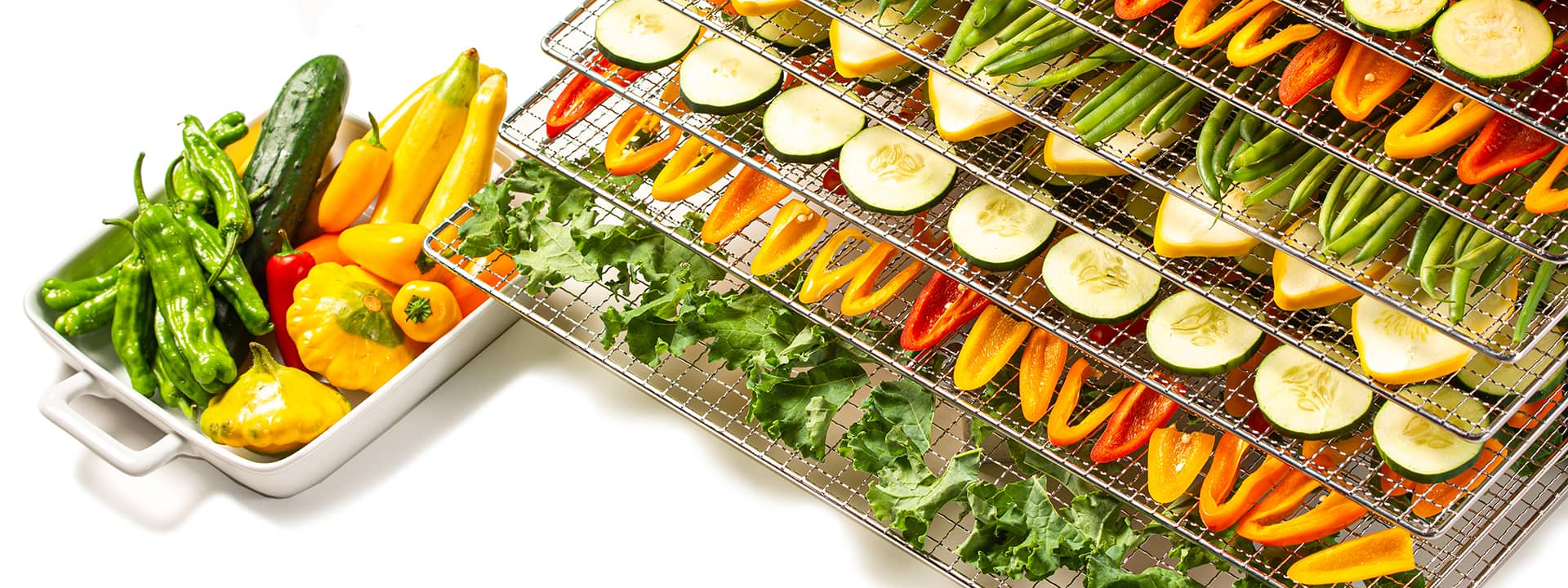
Dehydrating Vegetables
Not only are dried vegetables a tasty addition to your pantry, but dehydrating your own produce is a convenient and economical solution to food storage and reducing food waste. Dehydrated veggies take little room to store, have a shelf life of several months, and are easy to use. Campers and hikers also appreciate dehydrated vegetables for their light weight and small size.
Dehydration is one of the oldest methods of food preservation. The technique works by removing enough moisture—about 90 percent—from food so bacteria, yeast, and molds cannot grow. With its simple time/temperature control and compact size for storage, the Sahara Folding Dehydrator delivers the ultimate combination of performance and convenience for drying and preserving your favorite vegetables.
Prepping Vegetables for Drying
Delicious dried veggies start with good produce.
For the best flavor and texture, choose crisp, quality vegetables picked at peak maturity. Wash your produce in cool water with a brush to remove any soil and other residue. Drain and dry thoroughly. Trim any fibrous, woody, bruised, or spoiled spots and remove seeds and/or core when necessary.

Cut into thin, even slices.
One of the keys to evenly dehydrated vegetables is to cut your food into uniform slices, typically 1/8–1/4 inches (3–6 mm) in size. Make sure that all slices in the same batch are the same thickness. The smaller your pieces, the quicker your food will dry.
Blanch most vegetables before drying.
Drying your own food means avoiding additives often found in commercially dried products. Although pretreatment of your food isn’t necessary, many vegetables benefit from blanching (briefly boiling or steaming). Quickly blanching vegetables speeds drying, stops the enzymatic processes that cause spoilage, helps maintain color and flavor, and reduces the time needed to refresh your food before cooking. It is best to blanch vegetables that are particularly tough, such as carrots and corn and/or those you would not eat raw, such as asparagus and potatoes. Refer to the guide at the bottom of this page for specific preparation instructions as not all vegetables need blanching, and because blanching time varies by vegetable. Over-blanching may cause loss of flavor and color.
Avoid crowding your vegetables.
After blanching, submerge veggies in ice water to stop the blanching process. Once the food is cool enough to handle, drain well and pat dry with a towel to remove excess moisture. Arrange vegetable pieces in a single layer on our food-safe, silicone Sahara drying mats. There should be a small amount of space surrounding each piece.
How to Dehydrate Vegetables
Low heat and humidity, along with good air circulation, is critical for successful drying. Most vegetables are dehydrated until they are crisp and brittle for preservation and storage. Drying time will vary based on the vegetable’s water content, piece sizes, amount of food in the dehydrator, and humidity in your house. You can’t over-dry veggies, but you can scorch them if the temperature of your machine is too high. Smaller pieces—not higher temps—speeds drying.
Storing and Using Your Dried Vegetables
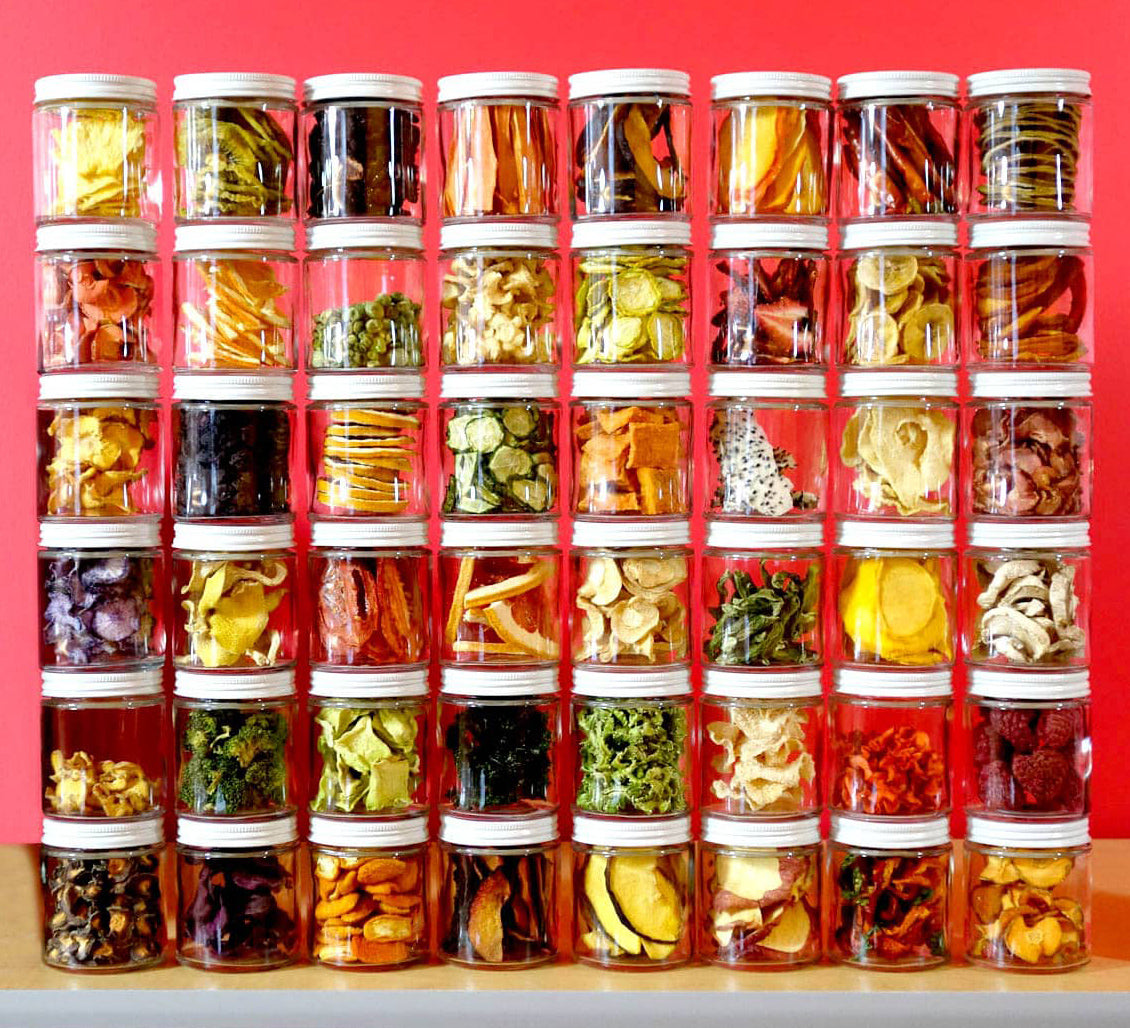
To extend their shelf life, nutritive value, flavor, and appearance, dehydrated veggies are best kept in airtight containers—such as glass jars, plastic freezer bags, or vacuumed packaging—in a cool, dark, and dry location. When stored properly, dried veggies are good for six months to one year. Discard any dried food that develops an odor or shows signs of mold.
Prevent condensation by letting your food cool completely before transferring to storage containers as well as packing foods in the amounts that will be used all at once while cooking. Each time your container is re-opened and exposed to air and moisture, the more likely your dried vegetables will spoil.
Dehydrated vegetables have a unique texture and flavor and should be reconstituted before eating. However, dried veggies do not need to be rehydrated before they are added to soups, stews, sauces, or casseroles. Just toss them into your recipe! Typically, one cup of dried vegetables is equivalent to 2 cups of fresh vegetables.
To rehydrate and cook:
- Tender vegetables (such as spinach, cabbage, or tomatoes): cover dried veggies with hot water and simmer until tender.
- Root, stem, and seed vegetables (such as carrots, green beans, or corn): soak in cold water for up to 90 minutes before cooking, then simmer until tender.
To grind into vegetable powder:
- For best results, cut large dehydrated vegetables into smaller pieces.
- Freeze for 10 minutes. Vegetables with a higher sugar content such as tomatoes and red peppers tend to gum up the blades of your grinder or food processor. Freezing helps prevent this from happening.
- Grind.
- Combat additional clumping in storage by mixing (up to 1 T) of arrowroot powder or cornstarch into your vegetable powder before placing it in a container. Silica packets also work. If your powder does clump over time, simply grind it again before using.
Best Vegetables to Dehydrate
Although dehydrating vegetables is relatively simple, it is not an exact science. The objective is to quickly remove moisture and microorganisms without scorching your food. Trial and error with your time and temperature settings is often needed to perfect this process at home. The Sahara Dehydrator’s simple-to-use dual time/temperature control allows users to program two times and two temperatures, ensuring food is adequately dried without compromising the flavor and texture of your vegetables.
Explore our recommendations below for prep, time, and temperature for a variety of veggies. And visit our recipe section for more dehydrated vegetable recipes, tips, and FAQs.
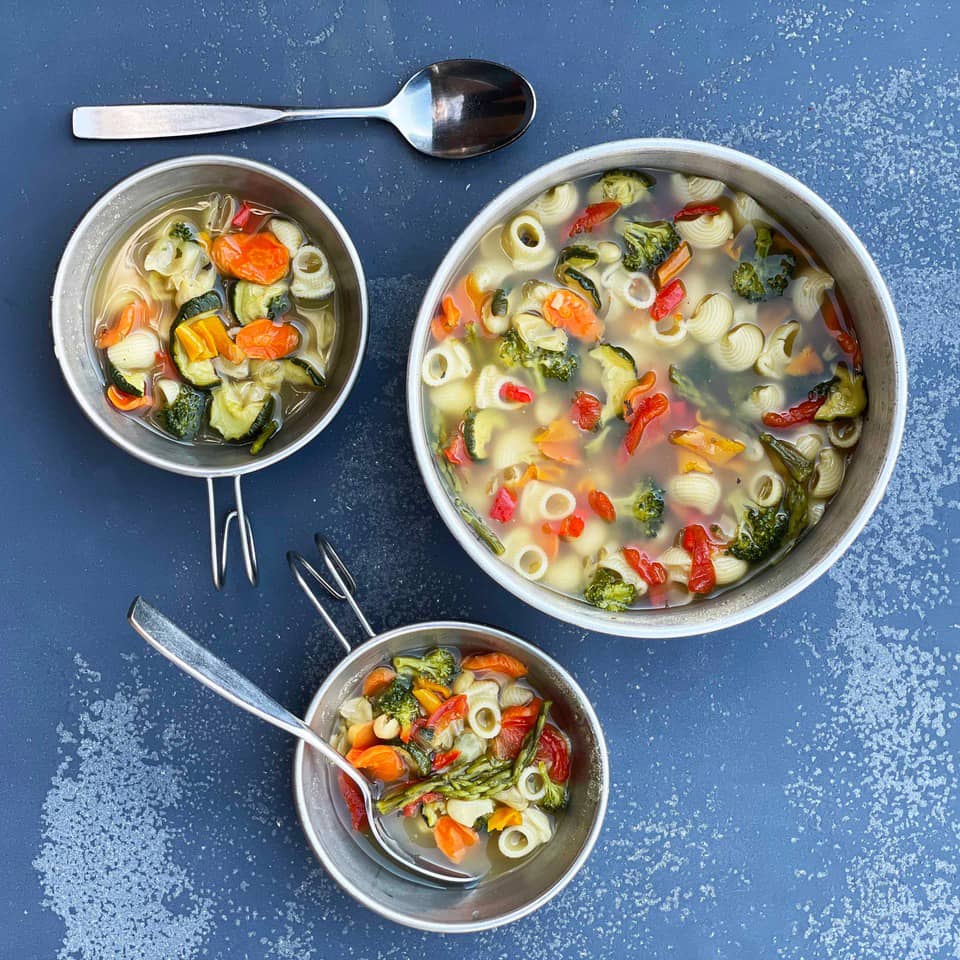
Vegetable Medley Soup Mix - Recipe

Asparagus
- Prep: Blanch for 3-4 minutes
- Time: 6-8 hours
- Temperature: 135ºF / 57ºC
- Dry until brittle

Avocados
- Prep: Remove the peel and seed
- Time: 8-10 hours
- Temperature: 135ºF / 57ºC
- Dry until leathery

Beets
- Prep: Cook and peel as usual; no blanching required
- Time: 10-12 hours
- Temperature: 135ºF / 57ºC
- Dry until brittle

Broccoli
- Prep: Blanch for 10 seconds
- Time: 3-6 hours
- Temperature: 135ºF / 57ºC
- Dry until brittle

Carrots
- Prep: Blanch for 3-4 minutes
- Time: 8 hours
- Temperature: 135ºF / 57ºC
- Dry until brittle

Celery
- Prep: Blanch for 5 seconds
- Time: 6-8 hours
- Temperature: 135ºF / 57ºC
- Dry until brittle

Corn
- Prep: Blanch for 1-2 minutes on the cob, then remove kernels
- Time: 8 hours
- Temperature: 135ºF / 57ºC
- Dry until brittle

Cucumbers
- Prep: Peel (optional)
- Time: 6-8 hours
- Temperature: 135ºF / 57ºC
- Dry until brittle

Eggplant
- Prep: Blanch for 2 minutes
- Time: 12-14 hours
- Temperature: 135ºF / 57ºC
- Dry until brittle
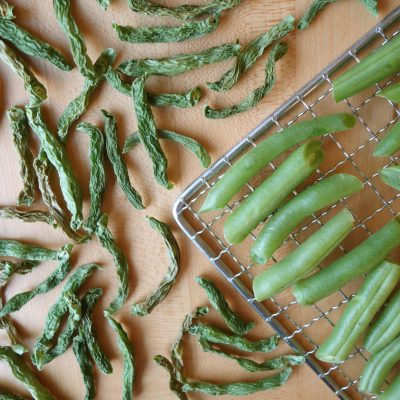
Green Beans
- Prep: Blanch for 2-3 minutes
- Time: 6-8 hours
- Temperature: 135ºF / 57ºC
- Dry until brittle

Jicama
- Prep: Blanch for 30 seconds
- Time: 8-10 hours
- Temperature: 135ºF / 57ºC
- Dry until brittle

Kale
- Prep: Blanch for 5-10 seconds
- Time: 3-5 hours
- Temperature: 115F / 46ºC
- Dry until brittle

Parsnips
- Prep: Blanch for 3-4 minutes
- Time: 6-8 hours
- Temperature: 135ºF / 57ºC
- Dry until brittle
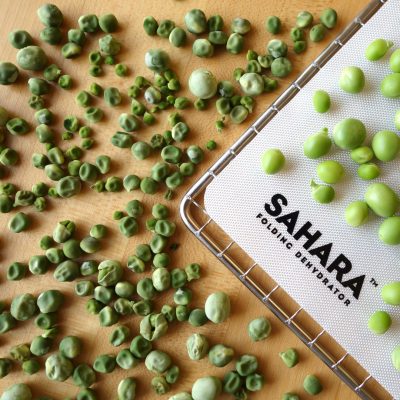
Peas
- Prep: Shell; blanch for 30 seconds
- Time: 5-13 hours
- Temperature: 125ºF / 52ºC
- Dry to brittle

Peppers, Cayenne, Habanada, and Hot
- Prep: Remove core and seeds (optional)
- Time: 5-10 hours
- Temperature: 135ºF / 57ºC
- Dry until brittle

Peppers, Sweet
- Prep: Remove core and seeds (optional)
- Time: 9-11 hours
- Temperature: 135ºF / 57ºC
- Dry until brittle

Tomatoes, Plum
- Prep: Remove core
- Time: 16 hours
- Temperature: 135ºF / 57ºC
- Dry until brittle
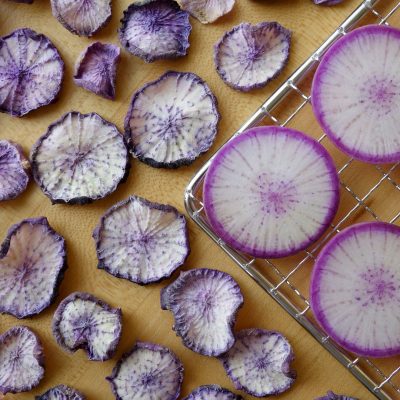
Radishes, Daikon Purple
- Prep: Blanch for 1 minute
- Time: 6-8 hours
- Temperature: 135ºF / 57ºC
- Dry until brittle

Rhubarb (Slices)
- Prep: Blanch 5 seconds
- Time: 6-8 hours
- Temperature: 135ºF / 57ºC
- Dry until brittle

Rhubarb (Straws)
- Prep: Use peeler for ultra-thin slices
- Time: 2-4 hours
- Temperature: 135ºF / 57ºC
- Dry until stiff coils are formed

Sea Beans
- Prep: Blanch for 5 seconds
- Time: 10 hours
- Temperature: 105ºF / 41ºC
- Dry until brittle

Squash, Yellow
- Prep: None
- Time: 12 hours
- Temperature: 135ºF / 57ºC
- Dry until brittle

Vegetable Confetti Mix
- Prep: Use silicone mats
- Time: 6-8 hours
- Temperature: 135ºF / 57ºC
- Dry until brittle

Zucchini
- Prep: None
- Time: 12 hours
- Temperature: 135ºF / 57ºC
- Dry until brittle
















